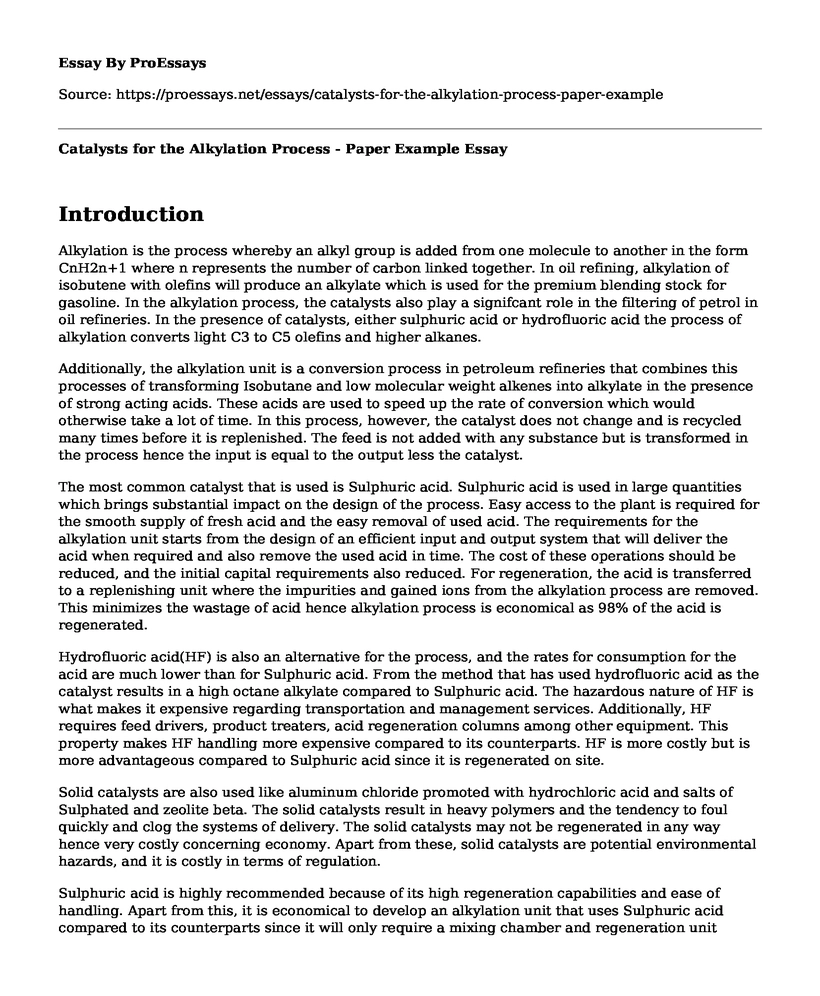Introduction
Alkylation is the process whereby an alkyl group is added from one molecule to another in the form CnH2n+1 where n represents the number of carbon linked together. In oil refining, alkylation of isobutene with olefins will produce an alkylate which is used for the premium blending stock for gasoline. In the alkylation process, the catalysts also play a signifcant role in the filtering of petrol in oil refineries. In the presence of catalysts, either sulphuric acid or hydrofluoric acid the process of alkylation converts light C3 to C5 olefins and higher alkanes.
Additionally, the alkylation unit is a conversion process in petroleum refineries that combines this processes of transforming Isobutane and low molecular weight alkenes into alkylate in the presence of strong acting acids. These acids are used to speed up the rate of conversion which would otherwise take a lot of time. In this process, however, the catalyst does not change and is recycled many times before it is replenished. The feed is not added with any substance but is transformed in the process hence the input is equal to the output less the catalyst.
The most common catalyst that is used is Sulphuric acid. Sulphuric acid is used in large quantities which brings substantial impact on the design of the process. Easy access to the plant is required for the smooth supply of fresh acid and the easy removal of used acid. The requirements for the alkylation unit starts from the design of an efficient input and output system that will deliver the acid when required and also remove the used acid in time. The cost of these operations should be reduced, and the initial capital requirements also reduced. For regeneration, the acid is transferred to a replenishing unit where the impurities and gained ions from the alkylation process are removed. This minimizes the wastage of acid hence alkylation process is economical as 98% of the acid is regenerated.
Hydrofluoric acid(HF) is also an alternative for the process, and the rates for consumption for the acid are much lower than for Sulphuric acid. From the method that has used hydrofluoric acid as the catalyst results in a high octane alkylate compared to Sulphuric acid. The hazardous nature of HF is what makes it expensive regarding transportation and management services. Additionally, HF requires feed drivers, product treaters, acid regeneration columns among other equipment. This property makes HF handling more expensive compared to its counterparts. HF is more costly but is more advantageous compared to Sulphuric acid since it is regenerated on site.
Solid catalysts are also used like aluminum chloride promoted with hydrochloric acid and salts of Sulphated and zeolite beta. The solid catalysts result in heavy polymers and the tendency to foul quickly and clog the systems of delivery. The solid catalysts may not be regenerated in any way hence very costly concerning economy. Apart from these, solid catalysts are potential environmental hazards, and it is costly in terms of regulation.
Sulphuric acid is highly recommended because of its high regeneration capabilities and ease of handling. Apart from this, it is economical to develop an alkylation unit that uses Sulphuric acid compared to its counterparts since it will only require a mixing chamber and regeneration unit which are the main parts. On the other hand, the employment of various components and numerous equipment that is required for the handling of HF is very costly, and the building of an alkylation unit that employs HF will need multiple environmental protection methods due to its hazardous nature.
Solid catalysts are not in use since it will bring a substantial increase in labor costs due to clogging and its non-regenerative nature that is wasteful. More research should be carried out to find out the various ways in which solid catalysts could be replenished.
Cite this page
Catalysts for the Alkylation Process - Paper Example. (2022, May 16). Retrieved from https://proessays.net/essays/catalysts-for-the-alkylation-process-paper-example
If you are the original author of this essay and no longer wish to have it published on the ProEssays website, please click below to request its removal:
- Weather and Disasters
- Essay Sample on Reservoirs Analysis
- Geology Essay Example: Reservoir Rock Wettability and Capillary Pressure
- Chemistry of Flame Retardant Materials
- The Properties of Life, Basic Chemical Terminology, and Molecules and Compounds of a Cell Necessary for Life
- Essay Sample on Hubble's Contributions to Astronomy
- My Goal is to Become a Biochemist - Free Paper Example







